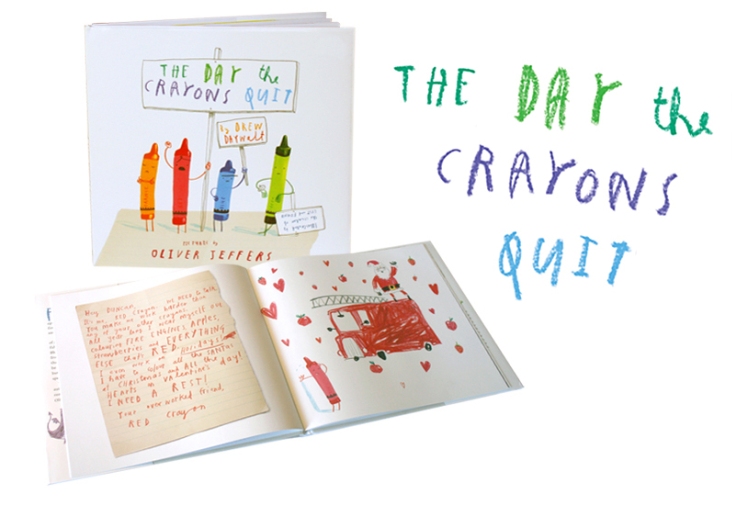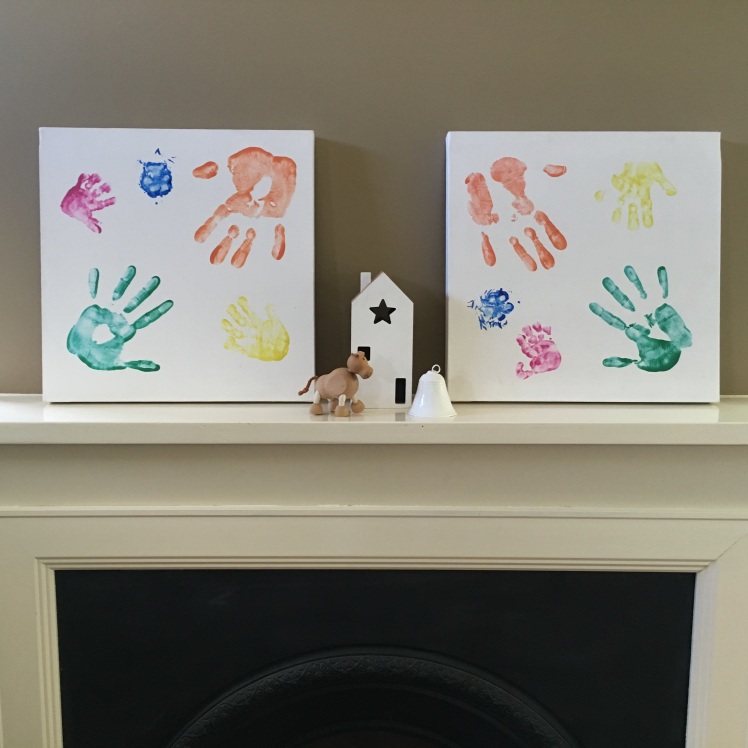
I’ve recently bought ‘The Day the Crayons Quit’ by Drew Daywalt and Oliver Jeffers. This is the first new picture book I’ve bought our family for a very long time. It is one of the most beautiful books I think I’ve ever read, and I am besotted with it!
If you haven’t read it, it revolves around a series of letters from the individual crayons to the small boy, Duncan, who loves to draw and colour in. Most of the crayons have left their box, leaving a letter explaining they haven’t been happy. Duncan, without realising it, has a limited way of seeing and using the crayons, and as a result, their potential has been limited (they are very articulate crayons). He’s also limited his own creativity and way of seeing the world.
This book is a delight to be enjoyed on so many levels. I savoured the way the story unfolds (the writing is beautiful), I contemplated the ideas each crayon raises in its letter to Duncan, I loved the visual appearance, and Duncan’s revelation at the end is wonderful. And my two kids, who I’d thought were past reading books like this, had already read it a number of times at school and love it. They saw it and squealed, and scurried away to read it with each other again. Which is a win, in my books.
And it got me thinking (as everything seems to, at the moment), about how we classify and group things. For good and bad reasons.
Simplifying and Categorising is good
When my son was around three or four, he loved to group things. All the cars had to be a certain size, he was for ever creating rows of evenly spaces blocks, and sorting things into patterns. Everyone in our household was allocated a favourite colour (mine is apparently ‘green’), favourite numbers (‘four’), and we were for ever looking up the biggest or tallest ‘something’ (bridge, road, building, lake, animal – the list went on). He still has this mentality, although it’s applied to other things now (most specifically, sporting statistics).
This sorting approach had its benefits. Clearly it was an approach he took to make sense of the world, when we are presented with so many new things every day (especially when you are a young kid). Trying to make sense of it all involves a certain amount of sorting, of classifying, in order not to be overwhelmed by it all.
As a result, he has a very good brain for maths (and it helps in playing sport, too – he sees the patterns in the game plan evolving in front of him). He loves the way authors express themselves – their word plays – plus he is attuned to what to say or do to reach out to others (he notes what’s important to other people, and follows through). It’s proven a great gift for kindness.
It also formed a useful distraction when I was trying to get things done when he was littler. More times than I can remember, we played ‘find the matching pair’ to hang socks on the line, and then to pair the socks when dry, in order to put things away. Which was very handy.
Being simplistic, judgmental, and narrow minded, with your categories, is wrong
It’s easier if we can make quick decisions to put people into boxes, isn’t it? Life can be complex, and if we can quickly sort through issues, it makes things easier, doesn’t it? Well, maybe. Maybe not.
The problems emerge when we form judgments based on categories we’ve developed, sometimes without even being conscious of them. And then we can turn our categories into limitations:
- If we see ideas, or people, as falling into only one category.For instance, because someone is good at X, we can’t possibly provide her the opportunity to do Y. She does X. X is what she will do. Forever! Arrggh! (imagine, too, what we – and she – might be missing out on).
- If we make our categories too broad or simplistic.We can then miss seeing the opportunities and potential of people and ideas (using a kid’s example – maybe it’s not that someone struggles with sport, but instead, they are better at ball sports rather than athletics. Give lots of things a try).
- If we attribute values to those categories – ‘good’ or ‘bad’, for instance, or ‘role models’ or ‘people we don’t want to be like’.No one is an extreme. We’re complex beings. No one is a saint – we all have flaws – and it is very rare for someone not to have even the slightly redeeming feature (of course, those features may not be enough for you to trust them – there are some limits. But in general, I find this to be true).
There are few people I haven’t learned something from, and there are few people I couldn’t help in some way.The same with an idea that may seems to us to be flawed- often there is still something worth considering or pursuing within it.
- If we consider people’s abilities and preferences to be fixedFor instance: ‘They are unreliable because they have let me down before. So I won’t give them a second chance’ – or ‘they like doing the cooking, so I don’t want to get in the way and disrupt what works’ or ‘they always write the best books so I KNOW I’ll love this new one’.
And we can do this categorising to ourselves, as well. People grow and change. It’s important to remember that – and give them, and ourselves, the opportunities (and the chance to have a break!). Plus – don’t judge if, in your opinion, they have an off day (even you, Ann Patchett, for not writing a book that shot again to the top of my favourites list. It’s ok).
- If we make the mistake of always thinking we have the full picture.We usually only see a limited picture -as much as we might try. Do we have the right to box someone permanently into a category? Are we also impacting ourselves as a result? There is so much we don’t know. We need to remain open to having our thinking changed.
- If we make the mistake of thinking a decision or judgment we make now needs to remain our decision or judgment for ever.An idea may seems to us now to be flawed, but there may be some element that is worth pursuing. Or, maybe now isn’t the right time, but in the future, it may be. Or any number of computations. Don’t always close opportunities completely.
Life in all its beautiful colours and shades.

Back to the reason each member of my little family was allocated a colour.
My son decided we needed to be allocated individual colours because, when my daughter was still a baby, we had an idea. We knew we were complete with our two kids and one dog, and we wanted to create something by our family unit, somehow.
To be honest, green is not my favourite colour. I love green, don’t get me wrong. But I love it more deeply than that.
- I love different shades of green.
- I love different intensities of green – in combination, and with other colours.
- And I love so many other colours. I love the interplay that they make together (usually – sometimes it’s a mess. But sometimes a mess can be glorious together. Sometimes).
Our son, who’d started kinder, loved art projects. And so we decided to do our own version of handprints (very popular in kinder groups). My son chose the colours for us (and yes, at the time, his favourite colour was yellow. Our new born daughter was less excited – it took us quite a few months before she’d stop closing her palm tightly every time we put paint on it. And our dog was non plussed (and kept trying to lick it off).
But eventually we managed to get an ‘all in together’ palm portrait of our family. High Five!
And really − it’s the combination of colours that makes this so special (oh, and the little hands, and the touch of hairiness around the dog pawprints. And all the feels).
But back to colour – Imagine if it was only green? It really wouldn’t have had the same impact, would it? Differences can make all the, well, difference.
I am a natural-born sorter too and can completely relate to your son. I am one of those people that separates my M&Ms into colours before I eat them. I have no eating preference beyond that… I’m not WEIRD or anything. LOL. So, yes, my inclination is to sort but, like you, that doesn’t extend to categorising people. Some things cannot be sorted at all. x
LikeLike
Ha, ha! If we were talking eating preferences, and if you got my husband’s ear, you could hear tales upon tales of my weird approaches (I always eat the food I dislike first, and I eat the crust first, for the same reason – yes, I’m still a child – and I sort lollies into patterns so I can keep them looking nice as I munch through and … )
I’ll stop there, because the sorting was about Sam and not me (no idea where he gets it from)! But other things? Not as much (at least, I try not to). As Pink Crayon said ‘can’t you colour the occasional pink dinosaur or monster’? We can learn a lot from this book …
LikeLike
This book looks delightful! I’ll keep my eye out for it. And I love the handprint pics!
LikeLike
It is a beautiful book if you have little ones (or even if you don’t)! And thanks – so glad we battled through with a reluctant dog and even more reluctant baby, because it’s a nice memory to have) x
LikeLike
I think grown-ups can still buy kids books for themselves!
LikeLiked by 1 person
Absolutely!
LikeLike
Good points – I like your thinking. I LOVE the handprint artwork. I wish I’d thought of this when my kids were little (now my hand would be the littlest) I think that’s worth framing 🙂
LikeLike
I adore the crayon book. Miss 4 is indifferent but I’ll persevere! great post, Helen 🙂 Handprint artwork rocks!
LikeLike
My eight year old love it, so it could actually be a book which school kids appreciate more. I think it’s worth persevering with. And yes, hand / pawprints are the best!
LikeLike
This book is a big favourite in our house. Good picture books are great fun to read time and time again but the ones I really love are the books that work on two levels. What kids see as just a funny book actually carries a deeper meaning. I’m in awe of children’s authors (and illustrators) who can write books like this!
LikeLike
Fantastic post! And this is such a great book! A favourite with the school kids.
LikeLike
And the author, Drew Daywent, liked my tweet on it, and said he had a new one coming out – Rock, Paper, Scissors (will be keeping an eye out for that!) 🙂
LikeLike